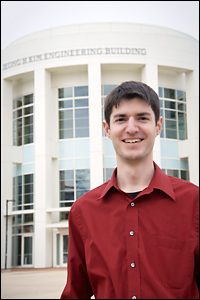News Story
MSE Grad Student, David Shahin, Receives Award for Diamond Tech Research

Photo courtesy of Patrick Stanley.
David Shahin, a Ph.D. student in the Department of Materials Science and Engineering (MSE) at the University of Maryland (UMD), took the 2nd Best Student Presentation Award at the Materials Research Society (MRS) Fall 2017 Meeting. Shahin offered his oral presentation, entitled, “Radiation Hardness of Hydrogen-Terminated Diamond Transistor and Diode Structures,” at the Diamond Electronics, Sensors, and Biotechnology Symposium in Boston, MA, on November 29th. The four-day symposium covered a variety of diamond topics including fundamental diamond material studies; power and RF devices; and biological, chemical and electrical sensing.
MRS meetings – offered in the Spring and Fall – serve as a stage for the “examination and dissemination of current and emerging materials research.” Thousands of researchers from all disciplines converge at these events to exchange information, network and contribute to the advancement of materials science research.
To that end, Shahin and his advisor, MSE Professor Aris Christou, offered up their latest research on diamond electronics.
“My research with Professor Christou is developing novel processing and devices for wide and ultra-wide band-gap semiconductors,” Shahin stated. “These materials – such as gallium nitride and diamond – have band-gaps between 3-5 times larger than that of silicon, which allows us to make electronics that withstand extreme voltages, operating frequencies, temperatures and other conditions that would be impossible for normal silicon devices.”
Diamond transistors are still a relatively young technology, but ultra-fast wireless communications, electric vehicle drivetrains, power grid and renewable energy management, and space power systems are just a few examples that could benefit from this technology.
“We use high quality single crystal diamond plates as a substrate to manufacture our devices on,” Shahin continued. “Diamond itself is an excellent electrical insulator, so we have to use special processes to create useful conductivity. We put the diamonds into hydrogen plasma at 700 degrees Celsius, which forms a layer of carbon-hydrogen bonds on the surface that we use to create a two-dimensional carrier channel near the surface. Then we fabricate our transistors, diodes and other test structures on top of this conducting channel.”
Another aspect of this technology that Christou’s group is studying is how resistant ‘diamond devices’ are to damage from various types of radiation.
“Radiation damage becomes a major concern for devices used, for example, in spaceflight systems and counter-WMD technologies,” Shahin explained. “Diamond is known to be extremely resistant to radiation damage, but we are one of the only research groups in the world to investigate how actual working diamond transistors and devices are affected by a variety of radiation types.”
To understand these effects, the group irradiates their devices using the University of Maryland Radiation Facilities and observes how the devices change, from both a materials and a device operation perspective.
Shahin indicated that the group seeks to use this information to develop models for how the structures degrade, where the weak points are, and how to implement new materials and device designs to combat these effects. “Early results shown at the MRS conference suggest that these devices may actually improve electrically, rather than degrade, under certain high radiation conditions,” he said.
Indeed, “this unique result combines radiation science with semiconductor devices to achieve a breakthrough in power electronics,” said Dr. Christou. “Diamond transistors will allow high efficiency wind and solar energy to become cheaper and more readily available. New applications in automobiles, and even in the home, could soon come to fruition.”
Additional contributors to this research include Kiran Kovi, Matthew Yung, Yizhou Lu, Alexander Yuan, Aaron Auerbach, Aayush Thapa, Ilya Ponomarev and James Butler. This work by the Christou research group is funded by the Defense Threat Reduction Agency (DTRA) and the National Science Foundation (NSF).
Related media:
Prof. Christou Leads Research of Diamond Electronics - UMD/MSE, Dec. 2016
Published December 11, 2017











